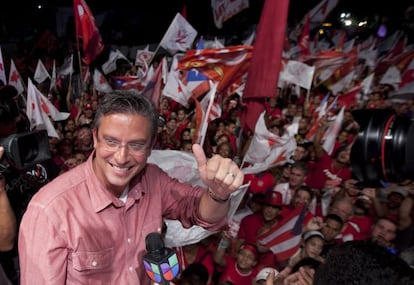Puerto Ricans vote in favor of statehood in non-binding plebiscite
Voters kick out pro-statehood governor, mayor following bitter race García Padilla promises his new administration will focus on jobs

Puerto Ricans on Tuesday voted in a plebiscite against their island’s status quo, with a majority saying that they would prefer statehood over current US commonwealth status. The non-binding vote was held parallel to the general election for a new governor, which was won by the pro-commonwealth Popular Democratic Party (PDP).
Alejandro García Padilla narrowly beat incumbent Governor Luis Fortuño of the pro-statehood New Progressive Party (NPP) in a bitter race filled with political tension and allegations of corruption from both sides.
With the Puerto Rican economy at a near standstill and wracked by high unemployment, García Padilla has said that his incoming administration will focus on job creation.
Fortuño, who had been in office since 2009, didn’t acknowledge defeat until Wednesday. His NPP party said that they wanted to ensure that every vote was counted because the race was so close.
García Padilla received 47.83 percent against Fortuño’s 47.05 percent.
The PDP took almost all the major races, including the San Juan mayoral race, which was won by Carmen Yulín Cruz. She defeated incumbent Jorge Santini, who had been in office for 12 years, by 6,000 votes.
A 69-year-old former Vietnam veteran, Pedro Peters Maldonado, also of the PDP, became the island’s first openly gay elected official when he won a seat on the San Juan city council.
But despite the voters’ preference for PDP candidates, they rejected their island’s status quo. The first question put to vote was whether Puerto Ricans favored their current status as a US territory. Some 54 percent said no.
The second question gave Puerto Ricans a chance to select from three options: statehood, sovereign free association or independence. Commonwealth, the current status, was not included on the ballot. Some 61 percent chose statehood with 33 percent selecting the semi-autonomous option.
It was the first time that statehood has won any of the referendums and plebiscites held over the past few decades. The US Congress, which has direct control over Puerto Rico’s affairs, has not made any firm commitments over whether it will start working to change the island’s status.
The nearly 4 million people who live on the island cannot vote in US presidential elections and do not receive full federal aid, as do the 50 states within the union. Puerto Rico became a US possession after the 1898 Spanish-American War in which Spain also lost Cuba and the Philippines to the United States.
Tu suscripción se está usando en otro dispositivo
¿Quieres añadir otro usuario a tu suscripción?
Si continúas leyendo en este dispositivo, no se podrá leer en el otro.
FlechaTu suscripción se está usando en otro dispositivo y solo puedes acceder a EL PAÍS desde un dispositivo a la vez.
Si quieres compartir tu cuenta, cambia tu suscripción a la modalidad Premium, así podrás añadir otro usuario. Cada uno accederá con su propia cuenta de email, lo que os permitirá personalizar vuestra experiencia en EL PAÍS.
¿Tienes una suscripción de empresa? Accede aquí para contratar más cuentas.
En el caso de no saber quién está usando tu cuenta, te recomendamos cambiar tu contraseña aquí.
Si decides continuar compartiendo tu cuenta, este mensaje se mostrará en tu dispositivo y en el de la otra persona que está usando tu cuenta de forma indefinida, afectando a tu experiencia de lectura. Puedes consultar aquí los términos y condiciones de la suscripción digital.








































